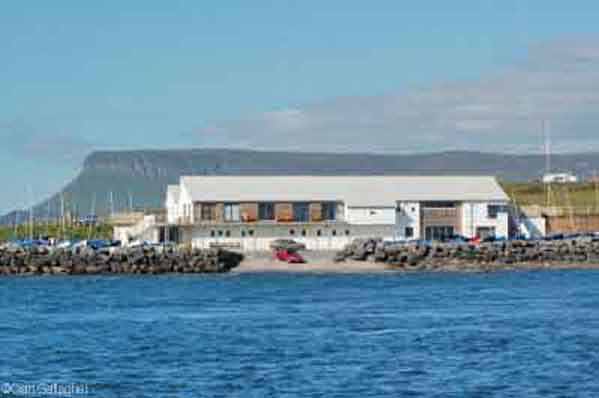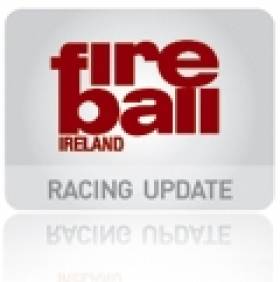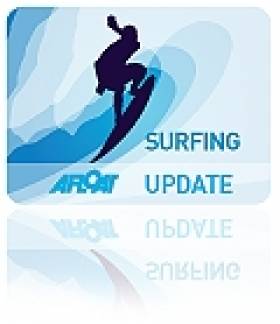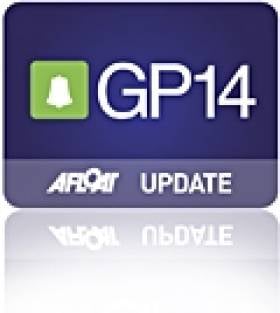Displaying items by tag: Sligo
Giant Prowler Wave Location Remains Secret
According to a Press Association report one of the six-man team, Briton Andrew Cotton, first spotted it several years ago while on board an Irish Coast Guard helicopter after being rescued from a surf accident off Mullaghmore, Co Sligo.
Last night some west coast surfers told Afloat.ie the location is most likely off the Sligo coast, up to two kilometres offshore and close to an underwater reef.
The terrifying-looking wave, dubbed 'Prowlers', was reportedly up to 50ft high on Tuesday when the Irish, British, Australian and South African surfers ventured out. Photos of it appeared on the front page of the Irish Times yesterday.
The surf team included Bundoran's Richie Fitzgerald who says he had waited for five years for the type of conditions required to surf it and on Monday the waves were in the 40-50ft range. Conditions were perfect due to the massive swell generated by Hurricane Tomas.
Fireballs Gear up for Worlds with New Video
Donegal Surfers Celebrate Top Showing at Easkey
John Britton of the famous Rossnowlagh surfing dynasty was among the winners at the Billabong Easkey Open in Co Sligo last weekend. (SCROLL DOWN FOR GREAT YOUTUBE VID)
The national school teacher from Ballyshannon took the senior title home to Donegal, site of next year's European Surfing Championships.
But Britton wasn't the only Donegal resident to enjoy success at Easkey, the final stop of the Irish Championships Tour.
Nicole Morgan from Tullaghan came tops in the women's event, retaining her Irish championship title. And although missing out on the national title, Emmet O’Doherty from Bundoran won out in the stand up paddle.
Junior talent Iarom Madden Travers from Bundoran also showed skill in the open finals, coming third behind Aaron Reid from Sligo and first place Fergal Smith from Mayo.
Sligo Yacht Club hosted the GP 14 Summer Open and Irish Youth Championships at Rosses Point on the 24th and 25th July.
26 boats lined up at the start. Gus Henry, himself a GP 14 sailor can always be relied upon to provide exceptional race management. He called back race 1 after a significant wind change. The race started proper a short while after that. Keith Louden and Dessie Hughes from Lough Foyle Yacht Club got to the weather mark first in 12 knots of wind, followed by local sailors Niall Henry and James Conlon. In third, Shane McCarthy and Al Fry followed close behind in their new boat. Niall Henry took line honours in the race after sailing a flawless race and taking the lead on the second beat. Paddy O'Connor and Tania McHale climbed from fourth to take second. McCarthy and Fry took third.
Race 2 followed shortly after. This time, there was a definite interest by Paul Maguire and Niamh McCormick from Sutton SC in the right hand side as the tide was picking up in pace. Alastair Duffin and Paul Whitcombe from Newtownards SC went that way too but not quite as far out. Shane and Fry chose the middle route, while the Mc Guinness Brothers from Moville Boat Club initially went left and then back into the middle right. At the weather mark, Maguire and McCormick had a clear lead with McCarthy and Fry in second with the McGuinness brothers a short distance away. The McGuinness brothers passed McCarthy and Fry on the second reach. Maguire and McCormick maintained their lead to the finish with half a boat length to spare at the end with the Donegal team a close second.
Race three got under way in similar wind to the first day but this time the tide was going out. The boats that went left looked good initially, but their hopes were soon dashed as the right side of the fleet piled in to the weather mark. Henry and Conlon though, who had sailed a middle course got to the weather mark first with about 7 boat lengths to spare. They let nothing slip and finished with a convincing first. With 1-5-1 in a four race series, they couldn't be beaten and didn't start race 4. The McGuinness brothers won race four taking the lead in the first reach, leaving them second overall. Conor Byrne and Pamela Lee, first time GP sailor were second and O'Connor and McHale finished third giving them third in the event.
The silver fleet was won by Nigel Sloane and Laura McFarland with Gerry Gilligan and Lucia Nicholson in second and Johnny Park and Bob Stinson in third.
The bronze fleet was won by Conor Byrne and Pamela Lee, Wai Manu and Don MacCormack in second and Bill Johnson and Stephen Byrne in third.
Mullaghmore Sailing Club
 Mullaghmore Sailing Club began in 1963 and ran mainly as a dinghy and cruiser club under the guidance of a founder member, the late Joan Malone's husband Paddy Malone. In terms of the Yacht and Sailing Club, we are a relatively new club. Initially MSC was composed largely of members from outside the area.
Mullaghmore Sailing Club began in 1963 and ran mainly as a dinghy and cruiser club under the guidance of a founder member, the late Joan Malone's husband Paddy Malone. In terms of the Yacht and Sailing Club, we are a relatively new club. Initially MSC was composed largely of members from outside the area.
However, in the seventies and eighties, there had been a subtle change in the sport of sailing which encouraged the sport to embrace all.
This was reflected in a change of the clubs’ name from the old Mullaghmore Yacht Club to Mullaghmore Sailing Club. Simultaneously membership increased, a new Clubhouse was built (1999) and an emphasis was placed on Junior Sailing and Special Needs Sailing with a view to building up a broad youth base to enable the future development of MSC.
The last fifteen years has seen the club grow from its hedge school in the old pioneering days operating in the open at the north slip in the harbour to our clubhouse with its excellent facilities. Membership is healthy. Many of our youth and junior sailors have enjoyed and still are participating in and enjoying the varied challenges of the sport. Adults who have not sailed before are taking to the water on our evening courses for adults.
The biggest event MSC hosts is the Mullaghmore Triathlon which now firmly established on the Triathlon circuit. Started in 2001 it is now a big event which draws hundreds of competitors and spectators in June each year.
All income for the club's activities is re-invested in training and water sport events, a commitment that is specified in the articles of association of the club. Each year, in conjunction with the Sligo VEC, MSC runs up to six weeks of junior sail training courses for 30 to 40 young people each day over this period.
MSC also runs sailing and navigation training for adults, major provincial and national sailing events and power boat courses. As a Recognised Training Establishment (RTE) all its courses and activities are certified under the Irish Sailing Organisation (ISA). The club is also committed to including people with special needs on sailing courses and have through the Peace and Reconciliation fund have invested in specially adapted access boats.
New club facilities opened April 2000. Active dinghy sailing and racing in sheltered waters from April to October. Visitor moorings available for cruisers. Annual Cruiser Regatta held at the end of July.
(Details and image courtesy of Mullaghmore Sailing Club)
Mullaghmore Sailing Club, c/o Andrea McElroy, Mullaghmore, Cliffoney, Co. Sligo. Email: [email protected]
Have we got your club details? Click here to get involved
Sligo Yacht Club
History
Sligo Yacht Club is located in Rosses Point on the edge of Sligo Bay – one of the most ideal and beautiful locations for inshore racing in the country.

The original Sligo Yacht Club was founded in 1821 and did most of its racing on Lough Gill. Records show that the club was not active since the end of the 19th century and was completely disbanded at the turn of the century. However, despite the non existence of a sailing club, Sligo had an excellent maritime history and there were several sailing craft on Lough Gill and Sligo Bay.
In 1965, six enthusiastic sailors got together to build GP14 class dinghies and these sailors formed the nucleus of the reactivated Sligo Yacht Club. Racing in GP14s took place in spring and autumn on Lough Gill, and during the summer months Sligo Bay was the venue for club racing. In the early 70s, Sligo Yacht Club commenced building the present Club house which was formally opened by the late President Childers on 14th September 1973.
In the last few years the Clubhouse has been extended and in 1987, the America's Cup Bar was added. Sligo Yacht Club has a healthy fleet of some 40 GP14s, 30 Mirrors, Laser Picos, Lasers and an ever increasing Cruiser Class. Racing for Cruisers take place on Wednesday and Fridays. The GP14s race on Tuesdays, Thursdays and Sundays while the Mirrors take to the water every day of the week during the summer holidays. The Club has a very enthusiastic Junior section and each year there is a well attended Junior Sail Training Course run under the auspices of the Irish Sailing Association. Introductory sailing for adults occurs early each spring and during the summer.
Running championships at National, European, and even World level does not present problems for Sligo Yacht Club. Sligo has a reputation for hosting major championships with a professionalism that is byword in sailing circles. The Club provides a 'happy mix' of excellent racing facilities backed up by a social programme that makes it one of the top clubs in the country.
Sligo Yacht Club hosted the Enterprise World Championships in 1979. In 1977 and again in 1980, the Scorpion Class held their European Championship in Sligo. The IDRA 14 Dinghy Class National Championships were hosted by Sligo in 1976, 1978, 1982 and 1983. The Club also hosted two very successful Dinghy Weeks in 1978 and again in 1983.
Mirror Week incorporating Junior and Senior National Championships was first hosted by Sligo in 1974, ten years later in 1984, in 1999 and again in 2003. In 1987, the Mirror World Championships took place in Sligo. In 2008, the Mirror European Championships will be held in Sligo.
In 1998, Sligo Yacht Club welcomed visitors from all over the country to Rosses Point for the GP14 National Championships, and in 2000 the Mermaid Nationals. The GP14 Class again came to Rosses Point for their Irish National Championships in 2005 as a prelude to the World championships of the GP14 Class which was hosted by Sligo Yacht Club. The event took place from July 30 to August 4 2006, and was the first major test for the new Clubhouse.
SYC has excellent facilities and beautiful sailing grounds. Cruiser racing takes place on Wednesday and Friday evenings while dinghy racing is on Tuesday and Thursday evenings and Sunday afternoon. Sailing season is from April to September. Bar open on sailing days. Courses run throughout the summer months.
(The above details and image courtesy of Sligo Yacht Club)
Sligo Yacht Club, Deadman's Point, Rosses Point, Co. Sligo. Tel: +353 71 9177 168, email: [email protected]
Have we got your club details? Click here to get involved

































































